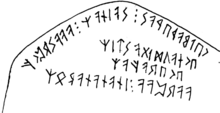ᛖᚲ
Jump to navigation
Jump to search
Proto-Norse
[edit]
Alternative forms
[edit]ᚴ and ᚳ are younger graphic variants of k, but do not indicate any change in pronunciation.
Etymology
[edit]From Proto-Germanic *ek, from Proto-Indo-European *éǵh₂.
Among the earliest attestations of the pronoun is the inscription on the 2nd-4th century Lindholm amulet, which also contains a postpositive, perhaps clitic, form of the pronoun in ᚺᚨᛏᛖᚳᚨ (hateka /haitē’ka/, “I am called”). For the forms with final -a, see ᛖᚲᚨ (eka).
Pronoun
[edit]ᛖᚲ (ek)
- I
- c. 250–450, inscription on the Tune stone:
- ᛖᚲᚹᛁᚹᚨᛉᚨᚠᛏᛖᚱᚹᛟᛞᚢᚱᛁᛞᛖ / […]
- ekwiwaʀafterwoduride / […]
- I, Wiwaz, after Woduridaz / […]
- c. 425, inscription on the Golden Horns of Gallehus:
- ᛖᚲᚺᛚᛖᚹᚨᚷᚨᛊᛏᛁᛉ᛬ᚺᛟᛚᛏᛁᛃᚨᛉ᛬ᚺᛟᚱᚾᚨ᛬ᛏᚨᚹᛁᛞᛟ᛬
- ekhlewagastiʀ:holtijaʀ:horna:tawido:
- I, Hlewagastiz Holtijaz, made the horn
- c. 250-450, inscription on the Hogganvik runestone:
- ᛖᚲᚾᚨᚢᛞᛁᚷᚨᛋᛏᛁᛉ / […]
- eknaudigastiʀ / […]
- I, Naudigastiz, / […] [1]
- c. 250–450, inscription on the Tune stone:
Related terms
[edit]- ᛗᛖᛉ (meʀ) (dative)
Descendants
[edit]- Old Norse: ek, iak — Old East Norse, -k — enclitic
References
[edit]- ^ James E. Knirk, Runic inscription from Hogganvik, Mandal, Vest-Agder (2009) (preliminary report), 27 October 2009